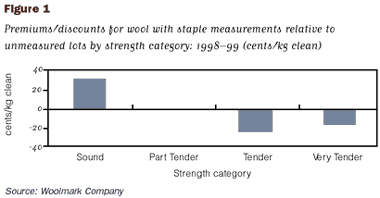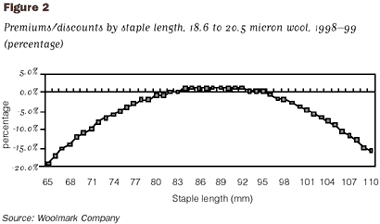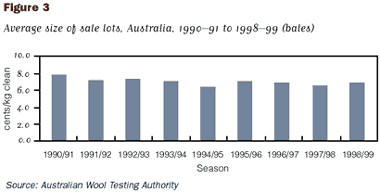
![]()
The growth of on-farm productivity and acceptance of new practices by Australian wool producers have been unimpressive over the past two or three decades, compared to most other farm products.
The reasons are complex, but part of the explanation lies with a natural reaction by growers to market signals. In other words, if a proposed change doesn’t improve the net return to growers, why do it?
Arguably, one of the most influential market signals was the collective message sent to growers by the Reserve Price Scheme which, for 20 years from 1971, told growers that they were assured a minimum price for their wool. The Scheme effectively reduced the incentive to improve on-farm performance.
That general factor aside, there are several specific instances in which grower decisions are influenced by the marketplace.
Staple measurements
Staple measurements (SM) of length and strength significantly improve the predictability of processing results. It is now an accepted practice for combing wools (86% tested in 1998/99), but it wasn’t achieved easily.
SM testing became available commercially in 1985/86 and by 1992/93 the adoption rate for combing wools was 47% (lead by Victoria and South Australia, held back by NSW and Western Australia). One reason for the slow uptake was simple economics. An early study (Stott 1990) estimated that growers offering SM wool in 1988-89 received, on average, an extra 3 cents/kg (all prices are ‘clean’ weight), compared to an average testing cost of 5 cents/kg.
That poor bottom line can be attributed, in part, to the common problem of no ‘critical mass’. In other words, there wasn’t enough being offered at auction to encourage buyers to compile mill consignments of SM wool. But there were other factors:
- Many buyers preferred their own judgement of length and strength, and there was insufficient pressure from mills to favour objectively measured lines.
- Some influential NSW brokers actively discouraged grower clients from having their wool measured for length and strength.
- WA growers were slower to embrace the new tests because WA wool was perceived to lack strength – so why draw attention to it?!
There is now a healthy premium for SM tested wool compared to untested lots (eg averaging 30 cents/kg for sound wool in 1998/99*), but there is a perverse twist. Measured tender wool (20 to 25 N/K tex) attracts a discount—25 cents/kg in 1998/99 relative to unmeasured equivalents (Figure 1). The reason is clear. Buyers often have instructions to exclude tender wool from a consignment, but that constraint can be avoided by including one or two lots of non-SM wool. As the quantity of non-SM wool falls, unmeasured tender lots attract a premium. (Figure 1)

Staple length
In the case of length measurement, growers have received a consistent message: if wool is too short it will attract a discount. However, growers are also being told that if combing wool is too long, particularly finer types, it will also attract a discount—16% in 1998/99 for 110mm 18.6 to 20.5 micron wool, which is only 15mm longer than full-priced lengths (Figure 2).

That is not a good message to send growers when they are being encouraged to improve productivity by increasing fleece weights, an outcome that usually involves higher staple lengths.
Moreover, CSIRO research has shown that the discount is unnecessary; spinners can obtain excellent results with long fine wool top. Trials are now in progress to demonstrate to spinners around the world the benefits of using long-Hauteur top and to ensure that those gains translate into better market demand for long stapled wool (The Wool Press, May 1999).
Sale lot size
Sale lots averaged 6.6 bales nationally in 1998/99 (Figure 3) and were as low as 5.3 bales in NSW. The low size contributes to the high cost of handling and distributing wool. Selling costs aside, storage costs for farm lots of, say, 5 bales are over $3 per bale higher than for lots of 10 bales, a differential which is not reflected in charges to growers.
The reasons for small lots are complex and rest partly with the way wool is classed on the farm, but it also reflects the grower’s hip pocket nerve! Put simply, small lots (< 10 bales) receive a premium at auction relative to larger lots, because of buyer demand. Small lots offer buyers much more flexibility in selecting lots to meet consignment specifications. The pattern is so well established that larger producers will often split their natural lines into smaller lots–a set back to reducing total distribution costs. (Figure 3).

Rehandled wool
Another factor contributing to the low average lot size is the discounts for sale lots that comprise an amalgamation of small farm lots (interlots and bulk class).
Buyers argue that rehandled wool is less homogeneous, does not process as well and should therefore be discounted. The discounts for interlots averaged 19 cents/kg nationally in 1998/99, but varied from a massive 47 cents in Northern Region to 12 cents in Southern Region.
The grower response is natural. Despite high (per kg) test charges, they prefer to offer small lots rather than incur discounted prices and brokers’ rehandling charges.
Shed accreditation
In an era where Quality Assurance has become the norm, the wool industry stands out as one that, currently, offers no such assurance. Brokers have tried. From the mid-1990s, several companies, at significant cost, introduced heavily promoted shed accreditation schemes. The trouble is they were independent of each other so that no single scheme could gain critical mass. Preliminary unpublished studies by the Wool Exchange show a modest premium for some shed-accredited fine wools, a result backed by an analysis in New Zealand of their Fernmark wools. However, sceptics argue that it is the better growers who are encouraged to join shed accreditation schemes and that the premiums paid reflect buyer knowledge of those clips.
The outcome may be more generally positive if all brokers support an industry scheme to be launched by the Wool Exchange in 2000.
The future
There is no reason why growers should stop responding to market signals. However, there is reason for the industry to become more integrated and to promote more actively to downstream users of wool the availability of new technologies and practices. That could involve also a streamlining of the handling and distribution system through to spinners—an ideal project for a cooperative research program!
Reference: Stott, Kerry J, ‘An Analysis of Premiums for Staple Measurement, and Price Differentials for Length and Strength Properties of Merino Combing Wool’, Australian Agriculture Economic Society Conference, Brisbane, February 1990.
|
* The assistance of Kerry Stott (Woolmark Company) in providing updated data is greatly appreciated
|
In this issue of The Wool Press: